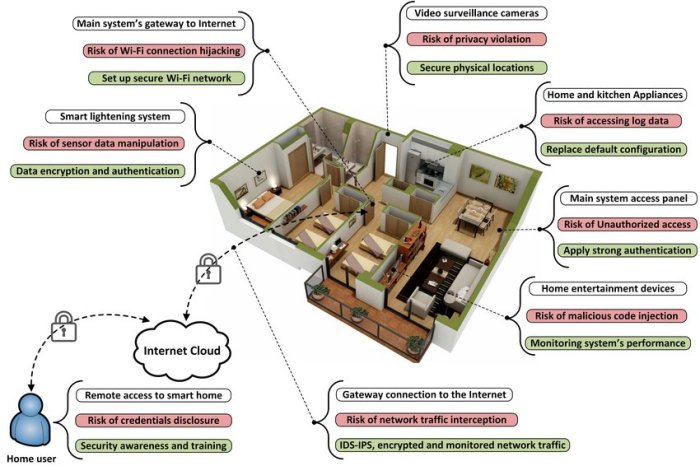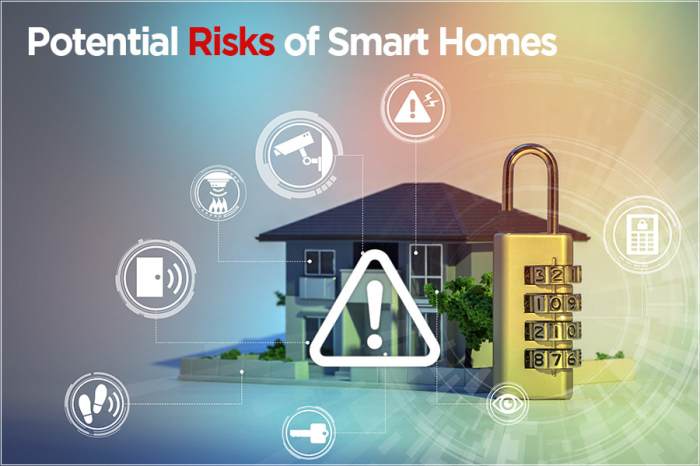Smart home system security risks and mitigation strategies are paramount in today’s interconnected world. As homes become increasingly integrated with technology, vulnerabilities arise, leaving homeowners susceptible to data breaches, unauthorized access, and even physical threats. The allure of convenience and automation offered by smart home devices comes at a price: a potential for exploitation by malicious actors seeking to exploit weak security measures and compromise sensitive information.
The rapid adoption of smart home technology has created a landscape ripe for exploitation. From vulnerable communication protocols to weak passwords and inadequate encryption, these systems often lack the robust security measures necessary to protect user data and privacy.
The consequences of such vulnerabilities can be severe, ranging from financial losses and identity theft to the compromise of personal safety and even physical harm. This underscores the urgent need for a comprehensive understanding of the security risks inherent in smart home systems and the implementation of effective mitigation strategies.
Future Trends in Smart Home Security: Smart Home System Security Risks And Mitigation Strategies

The realm of smart home security is constantly evolving, driven by advancements in technology and the increasing demand for sophisticated and robust protection. Emerging technologies are shaping the future of smart home security, offering both enhanced protection and new challenges.
AI-Powered Security Systems
AI is revolutionizing smart home security by enabling systems to learn and adapt to changing patterns and threats. AI-powered systems can analyze data from various sources, including cameras, sensors, and smart devices, to detect anomalies and potential security risks.
- Proactive Threat Detection:AI algorithms can analyze historical data and real-time information to identify suspicious activities, such as unusual movement patterns, unauthorized access attempts, or potential environmental changes. This allows for early detection and intervention, minimizing the risk of successful breaches.
- Personalized Security:AI can learn individual user behaviors and preferences, tailoring security measures to specific needs. For example, it can automatically adjust lighting schedules based on occupancy patterns, activate alarms when unusual activity is detected, or send alerts based on user-defined security parameters.
- Enhanced Intrusion Detection:AI-powered cameras can analyze video feeds in real-time to detect intruders, differentiate between humans and animals, and recognize familiar faces. This enables more accurate and efficient intrusion detection, reducing false alarms and improving response times.
Blockchain-Based Authentication, Smart home system security risks and mitigation strategies
Blockchain technology is emerging as a secure and transparent solution for authenticating smart home devices and users. Blockchain’s decentralized and immutable nature offers several advantages for enhancing security in the smart home ecosystem.
- Secure Device Authentication:Blockchain can be used to create a secure and tamper-proof record of each smart home device, ensuring its authenticity and preventing unauthorized access. This reduces the risk of counterfeiting and malicious devices entering the network.
- Enhanced User Authentication:Blockchain-based authentication systems can provide secure and verifiable user identities, minimizing the risk of unauthorized access and data breaches. This can involve multi-factor authentication, where users need to provide multiple forms of verification before accessing the system.
- Data Integrity and Privacy:Blockchain can help secure data stored on smart home devices and platforms. By storing data in a decentralized and encrypted manner, it can protect against unauthorized access and data manipulation, enhancing data integrity and user privacy.
Biometric Authentication
Biometric authentication, using unique biological characteristics for identification, is gaining traction in smart home security. This technology offers a more secure and convenient alternative to traditional password-based authentication methods.
- Fingerprint Recognition:Fingerprint scanners can be integrated into smart home devices, such as door locks, to allow access only to authorized users. This method is highly secure and convenient, as it eliminates the need for passwords or keys.
- Facial Recognition:Facial recognition technology can be used to identify users and grant access to smart home devices, such as security cameras or smart lighting systems. This technology can be used to personalize security settings and provide more targeted alerts.
- Iris Scanning:Iris scanning is a highly secure biometric method that uses the unique patterns in the iris of the eye for identification. This technology can be used to secure sensitive areas of the home, such as safes or private rooms, ensuring only authorized individuals can access them.
Wrap-Up

The future of smart home security lies in the adoption of innovative technologies and robust security protocols. As artificial intelligence (AI) and blockchain-based authentication continue to evolve, they hold the potential to enhance security and mitigate risks. By embracing these advancements, we can create a safer and more secure smart home environment, one that balances convenience with robust protection.
However, the responsibility for ensuring smart home security ultimately lies with the user. By prioritizing strong passwords, enabling multi-factor authentication, and regularly updating firmware, homeowners can significantly reduce their vulnerability to attacks. The future of smart home security hinges on a collaborative effort between developers, users, and security experts, working together to ensure that these systems are secure and reliable.
Okay, so smart homes are totally the future, but let’s be real, security is a vibe killer. Hackers can totally mess with your stuff, like turning on your AC at 3 am or ordering pizza to your house when you’re not even home.
But don’t worry, there are ways to stay safe. Think about investing in a sleek and stylish smart home system like the one featured in this article , which can be super secure if you use strong passwords and two-factor authentication.
You can even set up motion sensors and cameras to keep an eye on things, and maybe even get a cute little guard dog for extra protection.
Yo, smart home systems are super cool, but security is a real vibe-killer. Hackers can snoop on your data, mess with your gadgets, and even unlock your doors. But don’t sweat it! You can totally level up your security game with strong passwords, multi-factor authentication, and regular software updates.
Plus, if you’re feeling extra secure, check out Smart Home Systems with Extended Warranties: Peace of Mind and Savings for some peace of mind. It’s all about keeping those digital demons at bay, so you can chill in your smart home with no worries.
Sure, smart homes are super cool, but they can be a little vulnerable. It’s all about finding the right balance between convenience and security. That’s where reliable customer support comes in. Check out this article on Smart Home Systems: The Power of Convenience with Reliable Support for some solid tips.
Knowing how to properly set up your system and stay on top of updates is key to keeping your home safe and your peace of mind intact.